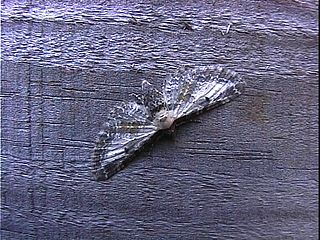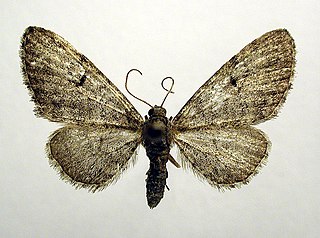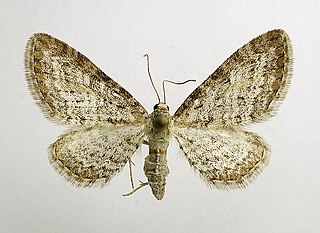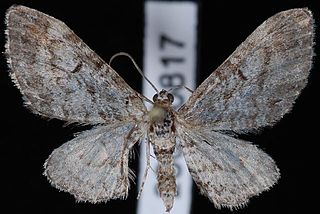
The tawny speckled pug(Eupithecia icterata) is a moth of the family Geometridae. It is found throughout the Palearctic region, the Near East and North Africa.

The bordered pug is a moth of the family Geometridae. It is found across the Palearctic region and the Near East.

Eupithecia innotata, the angle-barred pug, is a moth of the family Geometridae. The species was first described by Johann Siegfried Hufnagel in 1767. It ranges from Spain in the west to western Siberia and Central Asia in the east.

Eupithecia tantillaria, the dwarf pug, is a moth of the family Geometridae. It was described by Jean Baptiste Boisduval in 1840. The species can be found in the Palearctic ecozone.

Eupithecia inturbata, the maple pug, is a moth of the family Geometridae. The species can be found in central Europe, Great Britain and southern Scandinavia.

The cloaked pug is a moth of the family Geometridae. The species was first described by Johann August Ephraim Goeze in 1781 and it can be found in Europe and to the east in Siberia.

Eupithecia linariata, the toadflax pug, is a moth of the family Geometridae. The species can be found in Europe and from Anatolia to Tajikistan and Iran.

Eupithecia insigniata, the pinion-spotted pug, is a moth of the family Geometridae. The species can be found in Europe and Eastern Asia.

Eupithecia millefoliata, the yarrow pug, is a moth of the family Geometridae. The species was first described by Adolph Rössler in 1866 and it can be found in Europe and Russia.

Eupithecia tripunctaria, the white-spotted pug, is a moth of the family Geometridae. The species can be found from Europe to Korea and Japan and in North America.

Eupithecia venosata, the netted pug, is a moth of the family Geometridae. It was first described by Johan Christian Fabricius in 1787. It is found across the Palearctic ecozone from Portugal and Morocco in the west to the Lake Baikal in Siberia and Afghanistan and Pakistan in the east.

Eupithecia denotata, the campanula pug, is a moth of the family Geometridae. The species can be found from western Europe to central Asia and China.

Eupithecia egenaria, the pauper pug, is a moth of the family Geometridae. It is known from almost all of Europe, except Portugal, Ireland and the southern part of the Balkan Peninsula.

Eupithecia subumbrata, the shaded pug, is a moth of the family Geometridae. The species was first described by Michael Denis and Ignaz Schiffermüller in 1775. It is found from Mongolia and the Altai Mountains through Siberia, central Asia, Asia Minor and Russia to western Europe and from central Scandinavia to the Mediterranean region.

Eupithecia valerianata, the valerian pug, is a moth of the family Geometridae. The species was first described by Jacob Hübner in 1813. It is found from Great Britain, through central Europe to western Russia, Belarus and northern Iran.

Eupithecia distinctaria, the thyme pug, is a moth of the family Geometridae. It is found throughout Europe. It is also found in Iran.

Eupithecia massiliata, the Epping pug, is a moth in the family Geometridae. The species was first described by Pierre Millière in 1865. It is found in Western/Southern Europe and North Africa. It was recorded from Epping Forest in Essex in 2002. It is suspected that the specimens were accidentally imported.

Eupithecia graefi, or Graef's pug, is a moth in the family Geometridae. The species was first described by George Duryea Hulst in 1896. It is found in North America from south-western Alberta west to Vancouver Island, north to Alaska and south to California. The habitat consists of wooded areas.
Eupithecia pauxillaria, the parsimonious pug, is a moth in the family Geometridae. It is found in most of Europe, except Ireland, Great Britain, Portugal and northern Europe and the central part of the Balkan Peninsula.

Eupithecia scopariata is a moth in the family Geometridae. It is found in France, Spain, Portugal, Italy, Croatia, Greece and on Corsica and Sardinia.


















